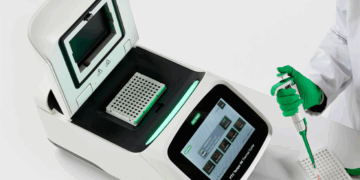Dive into an in-depth exploration of the molecular methods for gene expression profiling — highlighting the strengths, applications, and uses of qPCR, ddPCR, and RNA-Seq technologies.
Introduction
The study of gene expression offers fundamental benefits in biology (Rita 2021). Identifying the molecular basis of expressed genes can enhance our understanding of normal cellular processes, their alterations in pathological states, and their contributions to specific cellular phenotypes (LaTulippe et al. 2002, Segundo-Val and Sanz-Lozano 2016). Gene expression profiles can also help identify therapeutic targets or biomarkers in disease processes.
Three commonly used methods for studying gene expression at the RNA level include RT-qPCR (reverse transcription quantitative PCR), RT-ddPCR (reverse transcription quantitative Droplet Digital PCR) technology, and RNA-Seq (RNA sequencing via next-generation sequencing [NGS]). Utilizing a combination of these molecular methods can provide deeper insights than relying solely on a single technique when profiling gene expression or in other genomic applications.
Despite the commonalities between the three versatile PCR-based technologies, they have notable differences — not only in how they work but also in which genetic circumstances to employ them (Table 1). Depending on the research objectives, these methods can complement each other to maximize insights from gene analysis studies.
Table 1. Key benefits and applications of RNA profiling techniques.
|
Technique |
Strengths |
Key Features |
RNA-Seq |
|
|
RT-qPCR |
|
|
RT-ddPCR |
|
|
RNA-Seq: The Genome-Scale Discovery Method
RNA-Seq enables the sequencing of all RNA transcripts in a sample. It follows the same methodology as standard DNA sequencing except for converting RNA into cDNA through reverse transcription: genetic material is fragmented, sequencing libraries are prepared, and libraries are sequenced. The library can undergo single-end or paired-end sequencing. Single-end sequencing is the simplest method for utilizing RNA sequencing, whereas paired-end sequencing can produce high-quality, aligned sequence data.
For discovery purposes, especially in screening, RNA-Seq stands out as an ideal approach as it does not require prior knowledge of gene sequences, unlike PCR-based techniques. Thus, it offers a comprehensive, semi-quantitative, and unbiased perspective on all RNA transcripts within a sample. RNA-Seq facilitates the identification of novel gene-disease associations and regulatory microRNAs and enables simultaneous measurement of thousands of genes across various conditions through differential gene expression analysis.
In this process, researchers can compare transcriptomic profiles between different samples or experimental conditions, shedding light on key regulatory mechanisms underlying biological processes or disease states. Additionally, RNA-Seq’s semi-quantitative nature allows for the detection of both highly expressed transcripts and those at low levels, providing a comprehensive view of gene expression dynamics. The abilities of RNA-Seq make it an invaluable method for discovery and screening purposes and can serve as a valuable upfront tool before more targeted approaches such as qPCR or ddPCR methods are employed.
Bio-Rad’s specially designed NGS reagents, including the SEQuoia Complete Stranded RNA Library Prep Kit, ensure rapid, high-quality RNA-Seq results. With this prep kit, researchers can use limited and even degraded sample RNA to evaluate the whole transcriptome of a challenging sample and extract more information about different RNA biotypes. If higher-quality samples are available, users can shorten the library-prep workflow with the SEQuoia Express Stranded RNA Library Prep Kit. Its cost-effective, 3 hour, three-tube, automation-friendly solution enables the construction of robust libraries that efficiently capture long RNA transcripts (>200bp).
Learn more about NGS products from Bio-Rad.
RT-qPCR: The Well-Established Standard
RT-qPCR is an industry standard widely used in gene expression analysis for its high sensitivity, affordability, and ease of use. The method involves reverse transcription of RNA to cDNA, followed by real-time PCR amplification using fluorescent reporter molecules to monitor DNA accumulation in real time. Quantification is based on the quantification cycle (Cq), which indicates the number of cycles for the fluorescent signal to surpass a set threshold.
Its benefits include an assay format that is well established in molecular biology laboratories, with a rapid assay run time of 2 hours or less (Bardelle et al. 2015), making it suitable for high-throughput screening. Its broad dynamic range supports the analysis of highly concentrated samples without dilution (Majumdar et al. 2015). Moreover, RT-qPCR is easily automated, enhancing efficiency in laboratory workflows. Several instrumentation providers have already shown this advantage — for example, the Peak Robotics KX 2 is compatible with Bio-Rad’s CFX Opus 384 Real-Time PCR System for automated plate handling.
However, achieving near-perfect amplification efficiency and primer pair optimization for all target genes is essential for accurate results. RT-qPCR can only detect gene expression changes greater than two fold, and Cq values are not directly comparable between different assays. The presence of contaminants and different-source DNA between the sample and control can impact the accuracy of quantification, though controls and standard curves can improve quantitative ability.
RT-ddPCR: A Powerful Ultrasensitive Tool for Gene Expression
Droplet Digital PCR was developed as an alternative to traditional PCR. As each sample is partitioned into thousands of nanoreactions, ddPCR technology provides absolute quantification of RNA transcripts without the requirement for standard curves to quantify RNA or PCR efficiency.
Bio-Rad’s Droplet Digital PCR is a breakthrough technology that provides ultrasensitive nucleic acid detection and absolute quantification. Based on water-oil emulsion droplet technology, Droplet Digital PCR is particularly advantageous when working with low-abundance targets — below the level of detection for qPCR methods — and for detecting rare alleles against abundant wild-type backgrounds. Samples are fractioned into 20,000 nanoliter-sized droplets, and PCR amplification of the template molecules occurs in each individual droplet. This approach increases the scalability and practicality of earlier digital PCR techniques by partitioning the sample in one step, enabling the generation of thousands of data points from a single sample.
Choosing the Right PCR-Based Technology for an Application
qPCR and ddPCR technology are both valuable tools for gene expression analysis, each with its own advantages and considerations. qPCR continues to provide significant value for gene expression analysis in terms of its wide availability, ease of use, and dynamic range. Traditional qPCR assays typically require lower volumes of reagents compared to ddPCR technology, and multiplexing is possible with qPCR with a good supermix and an optimized assay. However, Droplet Digital PCR is easier for multiplexing as amplification efficiency is not an issue; this benefit can lower its cost per reaction. Overall, the specific cost-effectiveness of qPCR or ddPCR methods depends on the researcher’s experimental requirements.
For gene expression analysis, qPCR typically compares the gene of interest to reference genes without using a standard curve; the comparison is made between the gene of interest and reference genes. The utilization of a standard curve is primarily confined to assay optimization and validation processes, where the aim is to determine assay efficiency. However, when employing qPCR for absolute quantification of the target, a standard curve is run on every plate. In this regard, ddPCR technology presents an advantage, allowing for absolute quantification without the need for comparing to standards. Not needing this comparison also explains the utility of Droplet Digital PCR for absolute quantification of rare targets, as it relies on the ratio of positive to negative droplets. By utilizing Poisson statistics and the fraction of negative droplets (not containing the target), ddPCR technology can determine the absolute number of amplifiable nucleic acid copies per microliter of reaction, making it ideal for metrology applications involving nucleic acids. In fact, ddPCR technology can be used to create accurate nucleic acid standards for use in qPCR.
Droplet Digital PCR shines in scenarios with limited sample availability and higher multiplexing needs. Compared to qPCR, ddPCR technology also demonstrates greater tolerance to impurities in biological samples as it does not depend on a standard curve or perfect DNA amplification efficiency (Dingle et al. 2013). Its ability to reduce variability associated with PCR reactions can lead to cost savings by streamlining downstream analysis efforts.
Multiplexing is straightforward with Droplet Digital PCR as each droplet in a reaction can be tagged with specific fluorescent probes targeting different genomic regions or gene targets. This enables the quantification of multiple targets in a single experiment without compromising assay performance variability (Nyaruaba et al. 2021). In contrast, multiplexing in qPCR may require complex optimization of primer and probe combinations, potentially increasing experimental variability.
Although ddPCR technology offers advantages in certain scenarios, qPCR currently allows for higher-throughput applications. High-throughput qPCR (HT-qPCR) instruments can analyze up to 384 samples simultaneously, compared to 96 for ddPCR systems. HT-qPCR also offers opportunities for automation and integration into field-deployable devices, making it a convenient method for the simultaneous evaluation of many genes (Waseem et al. 2019).
Ultimately, the choice between qPCR and Droplet Digital PCR depends on the specific experimental requirements and balancing factors such as throughput, multiplexing needs, and tolerance to sample impurities. Both technologies have their place in the molecular biologist’s toolkit, offering versatile solutions for a wide range of applications.
To select the right PCR system for your research, researchers can use Bio-Rad’s PCR selector tool.
Combining Molecular Methods to Reveal Deeper Insights
Comprehensive gene expression analysis requires using multiple techniques to achieve optimal results. Using RT-qPCR, RT-ddPCR technology, and RNA-Seq in combination helps to address each methodology’s shortfalls with combinations of complementary protocols of different primary applications. A common example of this complementary synergy involves initially screening for changes in large groups of genes with RNA-Seq, followed by RT-qPCR or RT-ddPCR technology to target smaller gene subsets, thereby confirming or refuting results of the earlier broad screen (Costa et al. 2013, Everaert et al. 2017).
RNA-Seq is an excellent screening protocol that comprehensively analyzes transcriptome changes and profiles gene expression levels, thereby enabling the identification of gene-disease associations. Additionally, RNA-Seq can be used to identify potential drug targets by looking at the entire genome. Although NGS efficiency has increased over time, it is still challenging to obtain good read depths consistently. As such, Droplet Digital PCR has emerged as a valuable tool to improve the efficiency of the NGS workflow.
Specifically, integrating ddPCR technology into the NGS workflow can increase sequencing efficiency due to ddPCR’s partitioned amplification in droplets. Moreover, unlike standard PCR (where the entire reaction is in a single vessel), a target that is difficult to amplify has less competition from high-abundance molecules in a droplet. Difficult targets can be more easily amplified in the ddPCR system. Therefore, ddPCR methods more efficiently amplify difficult sequences, and their proportions in the library more closely approximate their relative representation in the initial sample. Better representation of sequences that are harder to amplify (and potentially less efficiently sequenced) results in more parallel reads in these areas. More parallel reads lead to increased read depth and potentially fewer ambiguous regions in the total sequence.
Moreover, qPCR and ddPCR technologies can be employed for library quantification before performing a sequencing run. Insufficient library input can cause missed rare targets, a reduced number of reads, a reduced ability to call single nucleotide polymorphisms (SNPs), poor coverage in some areas, and gaps in the sequence. qPCR using primers specific for the adapter sequence can be used for quantification, as only sequences with adapters (and thus will be sequenced) should be included in the measurement. The use of ddPCR technology further increases accuracy by providing absolute quantification. Depending on the quality control requirements and nature of the features to be verified, any sequencing findings (for example, a genomic anomaly linked to a disease phenotype) still need validation by different methods, especially to obtain more accurate quantification data than that obtained by sequencing or to screen larger populations of patients or samples. The use of Droplet Digital PCR for the validation of NGS results has been extensively studied and has the potential to become the standard approach for both genomics and transcriptomics research (Robin et al. 2016, Laurie et al. 2013, Olmedillas-López et al. 2017).
Conclusion
Combining RT-qPCR, RT-ddPCR, and RNA-Seq methods for gene expression profiling offers a multifaceted approach with distinct advantages. Each method captures different aspects of gene expression, providing complementary information that enhances overall understanding. RT-qPCR and RT-ddPCR methods serve as valuable validation tools for RNA-Seq findings, ensuring the reliability of results. While RNA-Seq offers insights into overall expression patterns, RT-ddPCR technology provides precise counts and a more detailed perspective of transcript abundance. Multiplexing, limited sample availability, and small fold changes in gene expression (10–20% differences) are areas where Droplet Digital PCR excels in genomic analysis, unique from qPCR. Integrating all three methods enhances accuracy and enables researchers to delve deeper into regulatory networks, splicing variants, and disease mechanisms — ultimately providing a more comprehensive understanding of cellular processes. Researchers can leverage the strengths of all three methods to obtain a holistic view of gene expression and uncover hidden complexities and deeper insights, particularly in complex biological or environmental contexts.
To learn more about gene expression technologies and other key genomics techniques, visit Bio-Rad’s Genomics Learning Center.
References
Bardelle C et al. (2015). Validation of miniaturized one-step reverse transcription qPCR assays for high-throughput screening and comparison to a reporter gene methodology. Assay Drug Dev Techn 13, 94–101.
Costa C et al. (2013). Comprehensive molecular screening: From the RT-PCR to the RNA-seq. Transl Lung Cancer Res 2, 87–91.
Dingle TC et al. (2013). Tolerance of droplet-digital PCR vs real-time quantitative PCR to inhibitory substances. Clin Chem 59, 1670–1672.
Everaert C et al. (2017). Benchmarking of RNA-sequencing analysis workflows using whole-transcriptome RT-qPCR expression data. Sci Rep 7, 1559.
LaTulippe E et al. (2002). Comprehensive gene expression analysis of prostate cancer reveals distinct transcriptional programs associated with metastatic disease. Cancer Res 62, 4499–4506.
Majumdar N et al. (2015). Digital PCR modeling for maximal sensitivity, dynamic range, and measurement precision. PLOS ONE 10, e0118833.
Nyaruaba R et al. (2021). Developing multiplex ddPCR assays for SARS-CoV-2 detection based on probe mix and amplitude based multiplexing. Expert Rev Mol Diagn 21, 119–129.
Rita B (2021). A mini review on gene expression. Insights Biomed 6.
Segundo-Val IS and Sanz-Lozano CS (2016). Introduction to the gene expression analysis. Methods Mol Biol 1434, 29–43.
Waseem H et al. (2019). Contributions and challenges of high throughput qPCR for determining antimicrobial resistance in the environment: A critical review. Molecules 24, 163.
Robin J et al. (2016). Comparison of DNA quantification methods for next generation sequencing. Sci Rep 6, 24067.
Laurie M et al. (2013). Simultaneous digital quantification and fluorescence-based size characterization of massively parallel sequencing libraries. BioTechniques 55, 61–67.
Olmedillas-López S et al. (2017). Current and emerging applications of Droplet Digital PCR in oncology. Mol Diagn Ther 21, 493–510.
Additional Resources
Harris K and Brown J (2022). Diagnostic yield of broad-range 16s rRNA gene PCR varies by sample type and is improved by the addition of qPCR panels targeting the most common causative organisms. J Med Microbiol 71.
Hindson BJ et al. (2011). High-throughput Droplet Digital PCR system for absolute quantitation of DNA copy number. Anal Chem 83, 8604–8610.
Wang D et al. (2022). ddPCR surpasses classical qPCR technology in quantitating bacteria and fungi in the environment. Mol Ecol Resour 22, 2587–2598.




